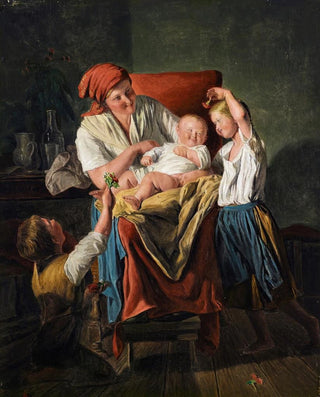Art print Mother luck - Ferdinand Georg Waldmüller | Art print


View from behind

Frame (optional)
In the rich and complex universe of art, some works manage to capture the very essence of humanity. "Mother Luck" by Ferdinand Georg Waldmüller is one of those creations that transcends the simple frame of painting to become a true reflection on the human condition. This piece, both poetic and realistic, invites us to explore themes of destiny, luck, and the choices we make throughout our lives. By delving into this representation, the viewer is transported to a world where emotions intertwine with impeccable painting technique, revealing the artist's skill in capturing life's nuances.
Style and uniqueness of the work
Waldmüller's style is distinguished by its naturalistic approach and meticulous attention to detail. In "Mother Luck," he manages to create an intimate atmosphere where each character seems to tell a story. The colors, carefully chosen, evoke a palette of feelings ranging from melancholy to hope. The expressions on the faces, finely crafted, demonstrate a deep psychological understanding of the subjects he depicts. The piece also stands out for its balanced composition, where each element finds its place within a harmonious whole. This ability to combine technique and emotion makes "Mother Luck" a centerpiece that leaves no one indifferent. The viewer's gaze is drawn to the interactions between the characters, symbolizing life's uncertainties and the choices that shape our destiny.
The artist and his influence
Ferdinand Georg Waldmüller, an emblematic figure of Austrian Romanticism, marked his era with his commitment to representing everyday life with unparalleled depth. Born in 1793, he established himself as a master of portrait and landscape, while incorporating narrative elements into his works. His influence extends far beyond Austria's borders, impacting generations of artists who saw in him a model of sensitivity and authenticity. Waldmüller was able to capture the spirit of his time, blending themes of daily life with broader reflections on human nature. "Mother Luck" embodies this duality,

Matte finish

View from behind

Frame (optional)
In the rich and complex universe of art, some works manage to capture the very essence of humanity. "Mother Luck" by Ferdinand Georg Waldmüller is one of those creations that transcends the simple frame of painting to become a true reflection on the human condition. This piece, both poetic and realistic, invites us to explore themes of destiny, luck, and the choices we make throughout our lives. By delving into this representation, the viewer is transported to a world where emotions intertwine with impeccable painting technique, revealing the artist's skill in capturing life's nuances.
Style and uniqueness of the work
Waldmüller's style is distinguished by its naturalistic approach and meticulous attention to detail. In "Mother Luck," he manages to create an intimate atmosphere where each character seems to tell a story. The colors, carefully chosen, evoke a palette of feelings ranging from melancholy to hope. The expressions on the faces, finely crafted, demonstrate a deep psychological understanding of the subjects he depicts. The piece also stands out for its balanced composition, where each element finds its place within a harmonious whole. This ability to combine technique and emotion makes "Mother Luck" a centerpiece that leaves no one indifferent. The viewer's gaze is drawn to the interactions between the characters, symbolizing life's uncertainties and the choices that shape our destiny.
The artist and his influence
Ferdinand Georg Waldmüller, an emblematic figure of Austrian Romanticism, marked his era with his commitment to representing everyday life with unparalleled depth. Born in 1793, he established himself as a master of portrait and landscape, while incorporating narrative elements into his works. His influence extends far beyond Austria's borders, impacting generations of artists who saw in him a model of sensitivity and authenticity. Waldmüller was able to capture the spirit of his time, blending themes of daily life with broader reflections on human nature. "Mother Luck" embodies this duality,
12,34 €






